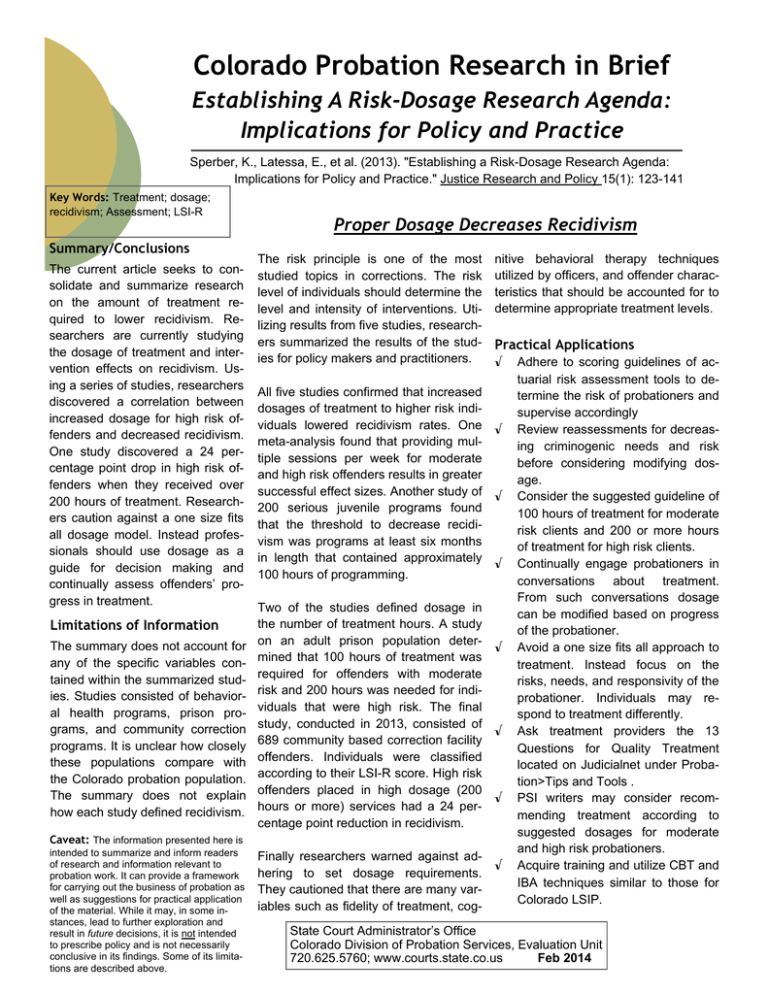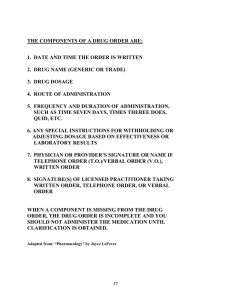Establishing a Risk-Dosage Research Agenda
advertisement

Colorado Probation Research in Brief Establishing A Risk-Dosage Research Agenda: Implications for Policy and Practice Sperber, K., Latessa, E., et al. (2013). "Establishing a Risk-Dosage Research Agenda: Implications for Policy and Practice." Justice Research and Policy 15(1): 123-141 Key Words: Treatment; dosage; recidivism; Assessment; LSI-R Summary/Conclusions The current article seeks to consolidate and summarize research on the amount of treatment required to lower recidivism. Researchers are currently studying the dosage of treatment and intervention effects on recidivism. Using a series of studies, researchers discovered a correlation between increased dosage for high risk offenders and decreased recidivism. One study discovered a 24 percentage point drop in high risk offenders when they received over 200 hours of treatment. Researchers caution against a one size fits all dosage model. Instead professionals should use dosage as a guide for decision making and continually assess offenders’ progress in treatment. Limitations of Information The summary does not account for any of the specific variables contained within the summarized studies. Studies consisted of behavioral health programs, prison programs, and community correction programs. It is unclear how closely these populations compare with the Colorado probation population. The summary does not explain how each study defined recidivism. Proper Dosage Decreases Recidivism The risk principle is one of the most studied topics in corrections. The risk level of individuals should determine the level and intensity of interventions. Utilizing results from five studies, researchers summarized the results of the studies for policy makers and practitioners. All five studies confirmed that increased dosages of treatment to higher risk individuals lowered recidivism rates. One meta-analysis found that providing multiple sessions per week for moderate and high risk offenders results in greater successful effect sizes. Another study of 200 serious juvenile programs found that the threshold to decrease recidivism was programs at least six months in length that contained approximately 100 hours of programming. Two of the studies defined dosage in the number of treatment hours. A study on an adult prison population determined that 100 hours of treatment was required for offenders with moderate risk and 200 hours was needed for individuals that were high risk. The final study, conducted in 2013, consisted of 689 community based correction facility offenders. Individuals were classified according to their LSI-R score. High risk offenders placed in high dosage (200 hours or more) services had a 24 percentage point reduction in recidivism. nitive behavioral therapy techniques utilized by officers, and offender characteristics that should be accounted for to determine appropriate treatment levels. Practical Applications √ √ √ √ √ √ √ Caveat: The information presented here is intended to summarize and inform readers of research and information relevant to probation work. It can provide a framework for carrying out the business of probation as well as suggestions for practical application of the material. While it may, in some instances, lead to further exploration and result in future decisions, it is not intended to prescribe policy and is not necessarily conclusive in its findings. Some of its limitations are described above. Finally researchers warned against adhering to set dosage requirements. They cautioned that there are many variables such as fidelity of treatment, cog- √ Adhere to scoring guidelines of actuarial risk assessment tools to determine the risk of probationers and supervise accordingly Review reassessments for decreasing criminogenic needs and risk before considering modifying dosage. Consider the suggested guideline of 100 hours of treatment for moderate risk clients and 200 or more hours of treatment for high risk clients. Continually engage probationers in conversations about treatment. From such conversations dosage can be modified based on progress of the probationer. Avoid a one size fits all approach to treatment. Instead focus on the risks, needs, and responsivity of the probationer. Individuals may respond to treatment differently. Ask treatment providers the 13 Questions for Quality Treatment located on Judicialnet under Probation>Tips and Tools . PSI writers may consider recommending treatment according to suggested dosages for moderate and high risk probationers. Acquire training and utilize CBT and IBA techniques similar to those for Colorado LSIP. State Court Administrator’s Office Colorado Division of Probation Services, Evaluation Unit 720.625.5760; www.courts.state.co.us Feb 2014



